01/10/23 - Canadian Christy Williams 24 years later ...
Christy Williams, here is another character with unique and particular aspects that deserve the consideration and attention of our entire world.
A woman dedicated to Trials so passionate that she is willing to sacrifice even the role of mother so as not to have to give up her favorite sport. A woman who with her wedding dress wanted to perform a couple of evolutions on her beloved mount, to reiterate how important trials are in her life.
He comes from Vancouver, in the far west of Canada, he is now 43 years old, and teaches trials to around twenty girls from his country. We met her in 1999, when attention was growing for the women's Trial - and we are not guilty of lacking modesty in reiterating it, everything was born thanks to us, in Torre Pellice, near Turin in 1997 with the first International Trial of the Vandalino, wanted and invented by phototrial, which then found a super valid creator in the Gentlemen's moto club of Pinerolo.
Three years of research around the world (without social networks, with faxes and expensive international phone calls) to find possible trialists and bring them together in a single Trial of Nations style competition, with also parades in the center of Torre Pellice of the teams behind their flags. From 1997 to 1999 the number grew rapidly: girls from the American continent, Japan, Australia, united with a large European group, demanded worldwide recognition for the category. And so the first official competition for the weaker sex was born in Seva in Spain in 2000 under the aegis of the FIM.
Following the recommendation of Laura Bussing, an American who was equally fanatical about trials at the time and who managed to establish a women's championship in the United States, we discovered a talented Canadian girl and it was immediately decided to invite her to participate in what was the third edition of the Vandalino women's Trial, in 1999.
From then on, for several years we saw each other either at the TdN or at the overseas round of the world championship.
For 10 consecutive years she defended the colors of Canada at the TdN, also participating in the women's world championship which in those years was held on the eve of it. She has won 10 US, 4 Canadian and 3 North American titles. Faithful to his favorite brand: Montesa.
Then a long stop and here we are again, with a few more years behind us in Auron, for the Trial of Nations. The Canadian now likes the idea of ??the interview as a minder and manager of her nation. Both of us sitting on the floor in a post-race moment where everyone was clearing out, to underline how little importance with formalities, we both have in common, here's what he told us.
When and where did you start in Trials?
I started in Trials in Vancouver, Canada. I was five years old.I had a Yamaha TY80. My father has been riding for many years and he makes me and my sister. We all ride.
Is your sister Kerry older than you?
Yes. Three years older. We both used the ty80.
And then what's happened?
Then I always rode and started to enter what we call local competition, always against men. There was not very many ladies, just me and my sister. In 1998, the NATC, the North American Trials Council made a class for women in the US Nationals. So I went, I watched one, I think I could do that and I started to practice more and more and my level went up. Before, there was no reason to practice or train because there was no real path for women. And once they made the class in 1998, there's a path for women.
Was Laura Bussing the inventor?
Yes, she and the Trials Training Center in Tennesee pushed for the women's class.
And in Europe was the first time that you ride when you came to Torre Pellice?
Yes, it was great , so often I find the pictures come up on Facebook or and it is amazing to think that there was so many women from so many countries who were interested and willing and pushing to be better because before this was always only for the men.
What else do you remember?
The competition was held also with vintage men's trials and the vintage men's trials was still quite far above what the women could do. So it's nice to see that now the women have come forward and come forward so much now.
Well, Vintage and Women was the first match in 1997, to find a motorcycle club willing to organize. You came two years later and the level of women was grown a lot, I agree. How was your competition?
I remember I was using the bike gave from Diego Bosis and I was so nervous because he is a famous person and I wanted to ride keeping it upright. I made many mistakes.
But then you, you stay out of the field for many years, true?
No. I rode the US nationals for 12 years and I got 12 American National championships and some Canadians as well. Then I took a break. I came back. In 2016 and I reached the second place. It was kind of a joke. We went to an event to ride for my 20th anniversary of riding that event. So I say to my dad, let's go on this trip together. My dad is my coach and my minder and so we go on this trip.
There was an American National in the way and he said to ride the national. I I haven't been training. I haven't doing anything. So I went and I rode the national and I come in 3rd and so then my sponsor says next year we do everything and so 2017 I do everything.
Compliments! Are you still competing?
I just trained for myself. You know, one day a week I come out on the bike and I I do training. But now I'm trying to make women's trials stronger in Canada. So for the past two years we have made women's training weekends.
And does it work?
We have 20 women come to train and from this training program we were able to make the first Trial des Nations Team in 15 years since I was riding that one.
I see, which is your role?
I'm here as a minder and manager.
In Canada now there is a championship for ladies or not?
Yes it is but the country is so big that we run one weekend championship every year and it goes from the West Coast one year and then the next year the East Coast. So we have a hard time having consistent because who lives on the West Coast and rides on the West Coast and then they skip the next year and and vice versa. There would be a possibility to have a championship for women, but even for the men it'd turn to be very expensive. Only in USA there is a championship, I think of 8 rounds, 8 weekends.
How many are the female riders in Canada?
Now it's hard to say again because the country is so big. The 20 or more that come to the school that I run in Vancouver, they all live within five or six hours. What happens in Toronto is 30 hours away. I honestly don't know.
You have just returned to Europe after many years. What is your impression?
The level of the section is crazy. It's so high and it's so impressive to see. I think now they have the challenge class on the yellow lines. It would be better having two lines for the ladies in TdN as there are two lines for TrialGP Women and Trial2 Women. This would help smaller Trials countries like Canada or Portugal and Latvia.
Anyway, everything here is so professional and the paddock is nice and the electronic cards to support the electronic scoring. I take these ideas home and I try to make our national series to be more professional and to make something that we can aim for.
What about to the riding? Do you think the riding is changing after 20 years?
It's more difficult because it's very technical move. I think Europe has always been more technical than North America for making sections. Yes, riding has changed with the no stop, it's a bit different …
Oh yes, what about no stop? Are you in favor or not?
I really liked when I was riding many years ago, they made two years with no stop but the rule was to get one point for stopping. I think this would be more fair because you still get a penalty for the stop but you don't ruin the day. And I think for the observers this is easier to hand out. No one wants to give Tony Bou five points because he stopped and then this ruins the whole championship. While if they can give Tony Bou one point, this would maybe make it more reasonable, more fair for everybody. I think in the top class they make this no stop because the sections are too dangerous.
What about your family? Is your husband riding Trials or not?
No. My husband is a welder so he makes metal welder. He makes metal with the sparks, the makes the metal stick together. So when I break my levers or I break my foot pegs, he can repair it immediately!
Did you choose him for this reason? Because it was necessary for the bike ?(laughing …)
Yes, I do not know how I rode before without having a husband who is a welder and can make metal. (laughing too)
Do you have any children?
No. having children means that it is hard to ride. Many of the women that I ride with when they have children, they stop riding. For me, Trials was more important and deserve great sacrifices.
What's your job?
I teach lessons of Trials. There's a a motocross track where they have motorbikes to rent and they have lessons every day.
Lessons of Motocross too?
Motocross beginner. I am a Trials rider. I do not go fast but everybody can work better improving his balance. So I take some trial skills and give to motocross riders.
Do you you have an other job?
Yes, I do the books for my husband's company. He owns his company and I do the accounting. It suits perfect for me, because the accounting job is quite small and also I can do that anytime.
So I can ride all day and then when the sun goes down I can do two or three hours of work and it's okay. It's very flexible.
What else do you like to do in your spare time? As Canadian do you like hockey, I guess?
No. My husband loves hockey and I had to learn everything about hockey back there. Like he has to learn all about trials . I had to learn all the hockey players because when I showed him videos of anybody who's riding, like Tony Bou, he has to know who this is. And when we watch hockey, I have to know who scored the goal. So we are teaching each other.
Do you like reading or listening to music?
I like to exercise. I have a university degree in kinesiology which is sports kinesiology, sports time.
I was making a training program to go for motorcycles because the movement can be quite specific. So we were doing most exercises holding handlebars with weights because this is how we move all the time on the motorcycle. I enjoy exercising a lot.
Any project for your future?
I would like to see more women in Trials, so I am teaching to about 20 girls in order they can grow up and compete soon. Also I'm working with the Canadian trials initiative, that is a small group in Canada,
who is trying to make programs that are sustainable for the TDN team. When my sister and I were part of the Canadian TDN team, we went to Europe for 12 years in a row, then none went for two years and then one men's team and then none again. It's been very up and down. So if we can create a program that is sustainable, then I think this will be beneficial. Moreover we're also trying to create funding for trials in Canada to help riders to move in a so wide country to ride the national.
Last but not the least, what do you think about the vintage trials? Have you ever tried?
My friends always say to try the vintage, t's so much fun but I always think the bike looks so heavy, the brakes don't work, it looks hard.
You could bend without hopping …
I like hopping, the only thing I'm good at. (smiling) So I find this makes me take away my best skills and then - you know - the brakes are bad and the it's so hard.
It's like when I tried to do Hard Enduro, I can do this but it's hard.
Wow, did you try some competitions, too?
I had two seasons of of hard Enduro. I had just retired from Trials for the first time to be married and spend time at home. And then they say, oh, now you're not riding trials, you have time for Hard Enduro. So I started to travel from Vancouver to Las Vegas or to Denver. But I say this is why I quit trials. And trials was even better, so I did not ride Enduro for a lot time.
---------------------------------------------------------------------------------------
La canadese Christy Williams, 24 anni dopo ...
Christy Williams, ecco un altro personaggio con aspetti unici e particolari che meritano la considerazione e l'attenzione di tutto il nostro mondo.
Una donna votata al Trial tanto appassionata da essere disposta a sacrificare anche il ruolo di madre pur di non dover rinunciare al suo sport preferito. Una donna che con l'abito di nozze ha voluto esibirsi in un paio di evoluzioni sulla sua amata cavalcatura, a ribadire quanto il trial sia importante nella sua vita.
Viene da Vancouver, nell'estremo ovest del Canada, oggi ha 43 anni, e insegna il trial a una ventina di ragazze del suo Pease. Noi l'abbiamo conosciuta nel 1999, quando stava nascendo l'attenzione per il Trial femminile – e non pecchiamo di mancata modestia nel ribadirlo, tutto è nato proprio grazie a noi, a Torre Pellice, vicino a Torino nel 1997 con il primo Trial Internazionale del Vandalino, voluto ed inventato proprio da phototrial, che poi ha trovato nel moto club Gentlemen's di Pinerolo un super valido realizzatore.
Tre anni di ricerca in giro per il mondo (senza social networks, a colpi di fax e costose telefonate internazionali) per scovare le possibili trialiste e riunirle in un'unica competizione stile Trial delle Nazioni, con anche sfilate nel centro di Torre Pellice delle squadre dietro le loro bandiere. Dal 1997 al 1999 il numero crebbe rapidamente: ragazze dal continente americano, dal Giappone, dall'Australia, unite a un cospicuo gruppo europeo reclamavano un riconoscimento mondiale per la categoria. E così che poi nacque a Seva in Spagna, nel 2000 sotto l'egida FIM la prima ufficiale competizione per il sesso debole.
Su segnalazione di Laura Bussing , statunitense altrettanto fanatica di trial a quell'epoca, quella che riuscì a istituire un campionato femminile negli Stati Uniti, venimmo a scoprire di una talentuosa ragazza canadese e subito fu deciso di invitarla a partecipare a quella che fu la terza edizione del Trial femminile del Vandalino, nel 1999.
Da allora per diversi anni ci si vedeva o al TdN o alla prova oltre oceano del mondiale.
Per 10 anni consecutivi ha difeso i colori del Canada al TdN, partecipando anche alla prova del mondiale femminile che in quegli anni si disputava alla vigilia. Si è fregiata di 10 titoli USA, 4 Canadesi e 3 nel Nord America. Fedele alla sua marca preferita: la Montesa.
Poi un lungo stop ed eccoci ancora qui, con qualche anno in più sulle spalle in quel di Auron, per il Trial delle Nazioni. L'idea dell'intervista piace alla canadese ora in veste di minder e manager della sua nazione. Seduti entrambi per terra in un momento post-gara dove tutti stavano sbaraccando, a sottolineare quanto poco affini alle formalità siamo entrambi, ecco cosa ci ha detto.
Quando e dove hai iniziato il Trial?
Ho iniziato con il Trial a Vancouver, in Canada. Avevo cinque anni e possedevo una Yamaha TY80. Mio padre faceva Trial da molti anni e ha trasmesso la passione a me e mia sorella. Andiamo col Trial tutti.
Tua sorella Kerry è più grande di te?
SÌ. Tre anni più vecchia. Entrambe abbiamo usato il TY80.
E poi cosa è successo?
Poi ho sempre fatto Trial e ho iniziato a partecipare a quelle che chiamiamo competizioni locali, sempre contro uomini. Non c'erano molte donne, solo io e mia sorella. Nel 1998, il NATC, il North American Trials Council, ha creato una classe per le donne nei Nazionali degli Stati Uniti. Così sono andata, ne ho guardato uno, penso che avrei potuto farlo e ho iniziato a esercitarmi sempre di più e il mio livello è aumentato. Prima non c’era motivo di praticare o allenarsi perché non esisteva un vero percorso per le donne. E una volta istituita la classe nel 1998, ecco un percorso per le donne.
Laura Bussing è stata l'inventore?
Sì, lei e il Trials Training Center del Tennesee hanno spinto per la classe femminile.
E in Europa è stata la prima volta che hai corso quando sei venuta a Torre Pellice?
Sì, è stato fantastico, così spesso trovo le foto su Facebook o ed è incredibile pensare che c'erano così tante donne provenienti da così tanti paesi che erano interessate, disposte e spingevano per essere migliori perché prima questo era sempre solo per gli uomini.
Cos'altro ricordi?
La competizione si è svolta anche con prove vintage maschili e le prove vintage maschili erano ancora abbastanza al di sopra di ciò che potevano fare le donne. Quindi è bello vedere che ora le donne si sono fatte avanti e il livello è così alto adesso.
Ebbene, Vintage and Women è stato il primo "meeting" nel 1997, per trovare un club motociclistico disposto ad organizzarlo. Sei arrivata due anni dopo e il livello delle donne è cresciuto molto, sono d'accordo. Com'è andata la tua gara?
Ricordo che stavo usando la moto prestatami da Diego Bosis ed ero molto nervosa perché lui è un personaggio famoso e volevo gareggiare senza rovinarla. Ho fatto molti errori.
Da quegli anni sei rimasta fuori dal giro per molti anni, vero?
No. Ho corso nelle nazionali statunitensi per 12 anni e ho vinto 12 campionati nazionali americani e anche alcuni canadesi. Poi mi sono presa una pausa. Sono tornata. Nel 2016 ho raggiunto il secondo posto. Era una specie di scherzo. Siamo andati a un evento per presenziare al mio 20 ° anniversario di quell'evento. Quindi dico a mio padre: facciamo questo viaggio insieme. Mio padre è il mio allenatore e il mio assistente e quindi facciamo questo viaggio.
C'era una prova nazionale americana sulla strada e lui ha detto di correrci. Non mi ero allenata. Non ho fatto niente. Così sono andata e ho corso la nazionale e sono arrivata terza e poi il mio sponsor disse che l'anno prossimo faremo tutto e quindi nel 2017 feci tutto.
Complimenti! Stai ancora gareggiando?
Mi tengo in forma solo per me stessa. Sai, un giorno alla settimana esco in moto e mi alleno. Ma ora sto cercando di ampliare i trial femminili in Canada. Quindi negli ultimi due anni abbiamo organizzato dei fine settimana di allenamento per le donne.
E funziona?
Abbiamo 20 donne che vengono ad allenarsi e da questo programma di allenamento siamo stati in grado di creare il primo Trial des Nations Team in 15 anni da quando correvo io.
Capisco, qual è il tuo ruolo?
Sono qui come minder e manager.
In Canada adesso c'è un campionato femminile oppure no?
Sì, c'è, ma il Paese è così grande che ogni anno organizziamo un campionato in un fine settimana che va dalla costa occidentale un anno e poi l'anno successivo dalla costa orientale. Quindi abbiamo difficoltà ad esserci tutte, perché chi vive sulla costa occidentale corre sulla costa occidentale e poi salta l'anno successivo e viceversa. Ci sarebbe la possibilità di avere un campionato femminile, ma anche per gli uomini costerebbe molto. Solo negli USA esiste un campionato, penso di 8 round, 8 weekend.
Quante sono le trialiste in Canada?
Adesso è difficile dirlo, di nuovo perché il Paese è così grande. Le 20 o più che frequentano la scuola che dirigo a Vancouver, vivono tutti entro cinque o sei ore. Quello che succede a Toronto è a 30 ore di distanza. Onestamente non lo so.
Sei appena tornata in Europa dopo molti anni. Qual è la tua impressione?
Il livello delle zone è pazzesco. È così alto ed è così impressionante da vedere. Penso che ora abbiano la classe top tra le bandierine gialle. Sarebbe meglio avere due livelli per le donne nel TdN, in quanto ci sono due livelli per TrialGP Women e Trial2 Women. Ciò aiuterebbe i paesi più indetro per il Trial come il Canada, il Portogallo e la Lettonia.
Comunque qui è tutto molto professionale, il paddock è carino e le schede elettroniche supportano il punteggio elettronico. Porto queste idee a casa e cerco di rendere le nostre serie nazionali più professionali e di realizzare qualcosa a cui possiamo aspirare.
E la guida? Pensi che modo di guidare stia cambiando dopo 20 anni?
È più difficile perché è diventata molto tecnica. Penso che l’Europa sia sempre stata più tecnica del Nord America per quanto riguarda la realizzazione delle sezioni. Sì, la guida è cambiata con il no stop, è un po' diversa…
Oh sì, che ne dici del "no stop"? Sei favorevole o no?
Mi è piaciuto molto quando correvo tanti anni fa, facemmo due anni senza potersi fermare ma la regola era di prendere un punto, fermandosi. Penso che questo sarebbe più giusto perché ricevi comunque una penalità per la sosta ma non ti rovini la giornata. E penso che per i giudici questo sia più facile da attribuire. Nessuno vuole dare cinque punti a Toni Bou perché si è fermato e poi questo gli rovina tutto il campionato. Mentre se potessero dare un punto a Bou, questo forse renderebbe la cosa più ragionevole, più giusta per tutti. Penso che nella classe top lo facciano no stop perché le sezioni sono troppo pericolose.
Qual ??è il tuo lavoro?
Do' lezioni di Trials. C'è una pista di motocross dove hanno moto da noleggiare e tengo lezioni ogni giorno.
Lezioni anche di Motocross?
Principianti di Motocross. Sono un pilota di Trial. Non vado veloce ma tutti possono lavorare meglio migliorando il proprio equilibrio. Quindi trasmetto alcune abilità di Trial ai piloti di Motocross.
Hai un altro lavoro?
Sì, mi occupo della contabilità per l'azienda di mio marito. È proprietario della sua azienda e io mi occupo della contabilità. È perfetto per me, perché il lavoro di contabilità è piuttosto piccolo e posso farlo in qualsiasi momento.
Quindi posso guidare tutto il giorno e poi quando il sole tramonta posso fare due o tre ore di lavoro e mi sta bene. È molto flessibile.
Cos'altro ti piace fare nel tuo tempo libero? Come canadese ti piace l'hockey, immagino?
No. Mio marito adora l'hockey e lì ho dovuto imparare tutto sull'hockey. Come lui ha dovuto imparare tutto sul Trial. Ho dovuto conoscere tutti i giocatori di hockey perché quando gli mostravo i video di chiunque trialeggiasse, come Bou, doveva sapere chi era. E quando guardiamo l'hockey, devo sapere chi ha segnato il gol. Quindi ci stiamo insegnando a vicenda.
Ti piace leggere o ascoltare musica?
Mi piace fare sport. Ho una laurea in kinesiologia che è kinesiologia sportiva, tempo sportivo.
Stavo realizzando un programma di allenamento per andare in moto perché il movimento deve essere piuttosto specifico. Quindi eseguivamo la maggior parte degli esercizi tenendo il manubrio con dei pesi perché è così che ci muoviamo continuamente sulla moto. Mi piace molto fare del movimento.
Qualche progetto per il tuo futuro?
Mi piacerebbe vedere più donne nel Trial, quindi sto insegnando a circa 20 ragazze in modo che possano crescere e competere presto. Inoltre sto lavorando con la Canadian Trial Initiative, che è un piccolo gruppo in Canada,
che sta cercando di realizzare programmi sostenibili per il team TDN. Quando io e mia sorella facevamo parte della squadra canadese TDN, siamo andati in Europa per 12 anni consecutivi, poi nessuno ci è andato per due anni, poi una squadra maschile e poi ancora nessuna. Ci sono stati molti alti e bassi. Quindi, se riusciamo a creare un programma sostenibile, penso che ciò sarà vantaggioso. Inoltre stiamo anche cercando di trovare finanziamenti per le gare in Canada per aiutare i trialisti a spostarsi in un Paese così vasto da poter correre in nazionale.
Ultimo, ma non meno importante, cosa ne pensi del mondo vintage? Ci hai mai provato?
I miei amici dicono sempre di provare una moto da trial vintage, è divertente ma penso sempre che la moto sia così pesante, che i freni non funzionino, mi sembra dura.
Potresti curvare senza "spostare"...
Mi piace spostare, l'unica cosa in cui sono brava. (sorride) Quindi trovo che questo mi porti via le mie migliori capacità e poi - sai - i freni sono pessimi ed è così difficile.
È come quando ho provato a fare Hard Enduro, posso farlo ma è difficile.
Wow, hai provato anche qualche gara?
Ho fatto due stagioni di Enduro estremo. Mi ero appena ritirata dal Trial per la prima volta per sposarmi e trascorrere del tempo a casa. E poi dicono, oh, ora non stai facendo il Trial, hai tempo per l'Hard Enduro. Così ho iniziato a viaggiare da Vancouver a Las Vegas o a Denver. Ma poi mi sono detta che questo è il motivo per cui ho rinunciato ai Trial. E le gare di Trial erano ancora migliori, quindi non ho corso nell'Enduro per molto tempo.
------------------------------------------------------------------------------------------
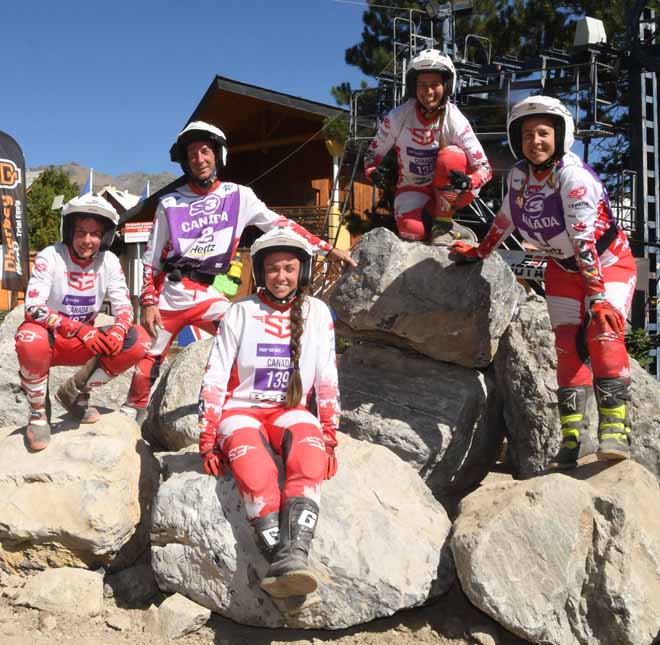
on right, minder and manager at the TdN in Auron, 3 weeks ago /a destra, assistente e dirigente del TdN di Auron, 3 settimane fa
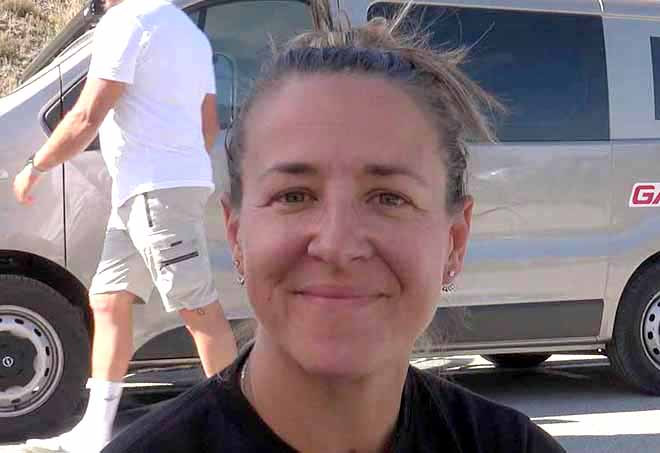
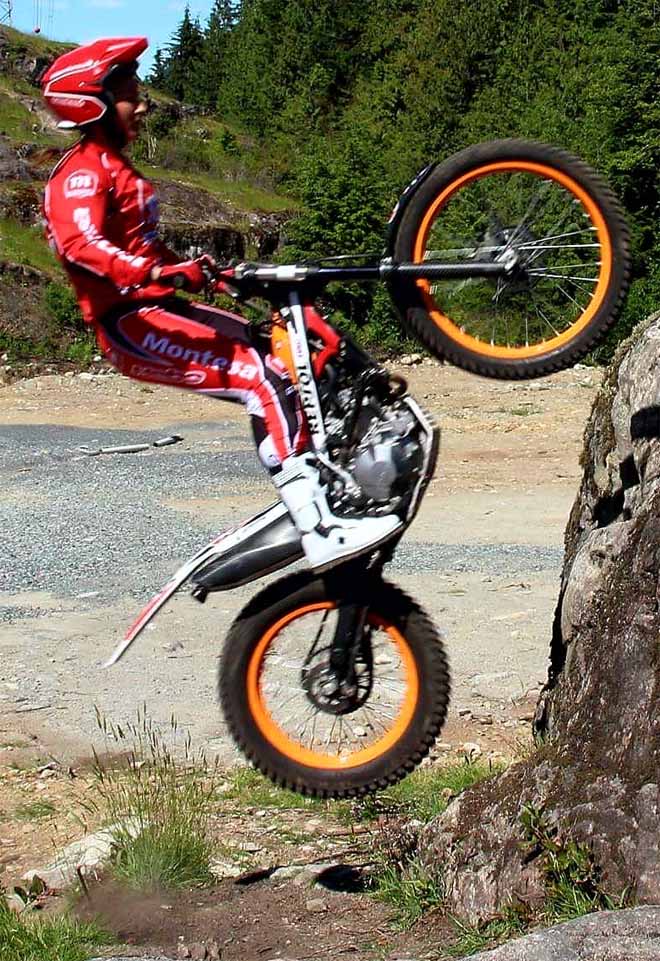
training on his favorite brand: Montesa/allenandosi con il suo marchio preferito: Montesa
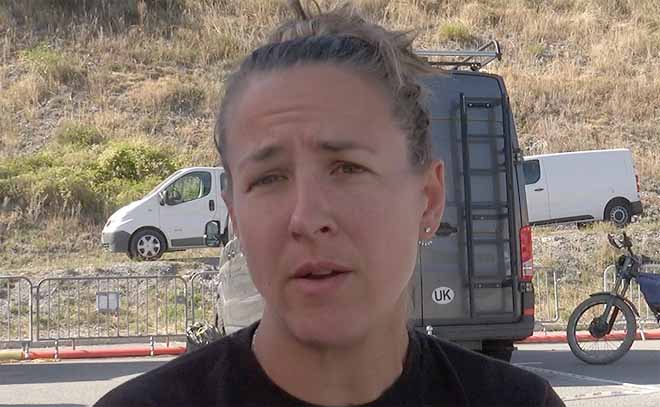
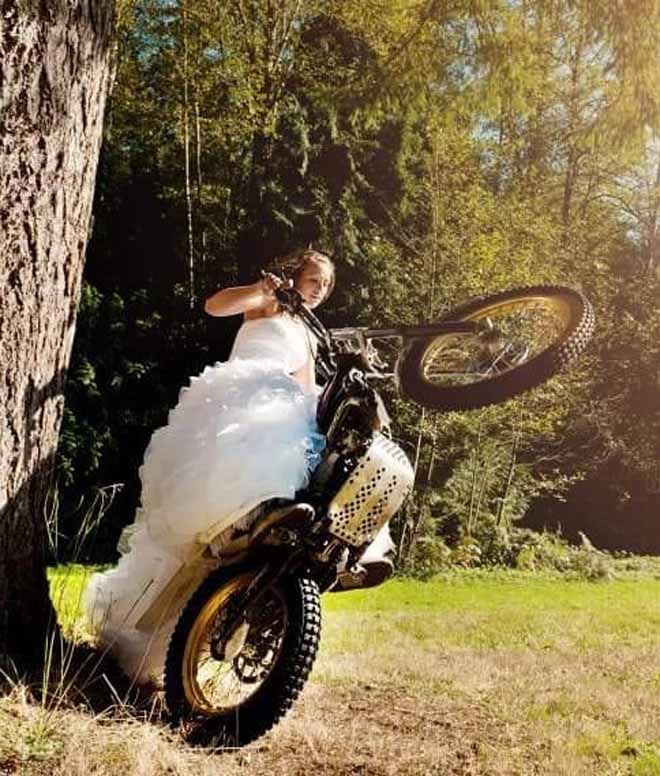
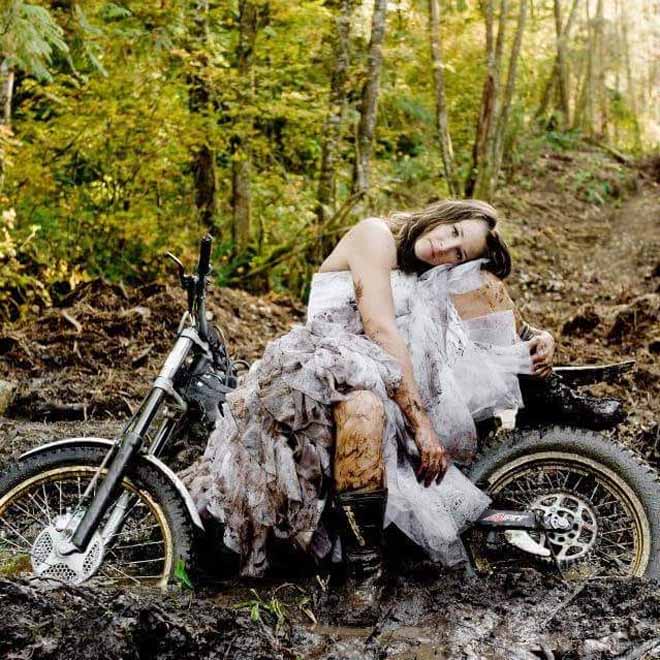
wheelieing and practicing on her wedding day!/ impennando e girando il giorno del suo matrimonio!

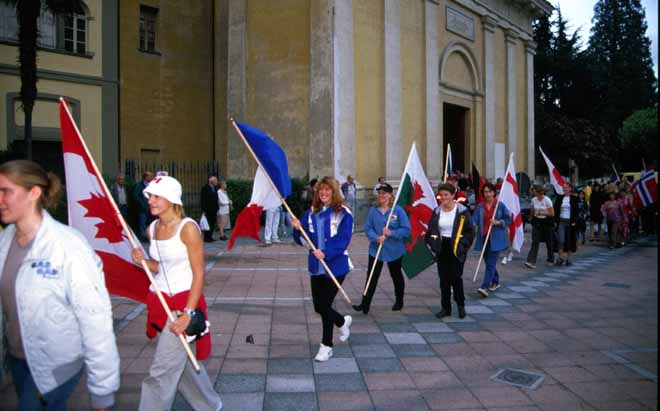
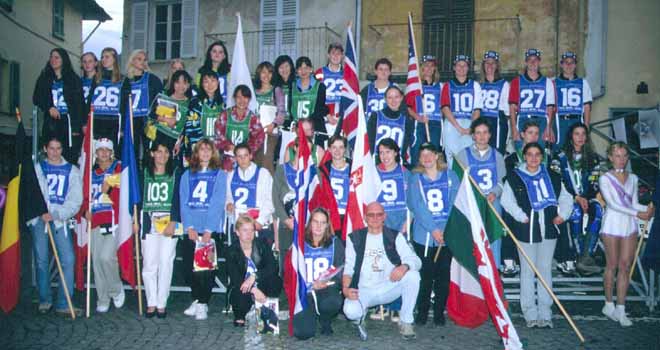
1999 Torre Pellice TO, Italy
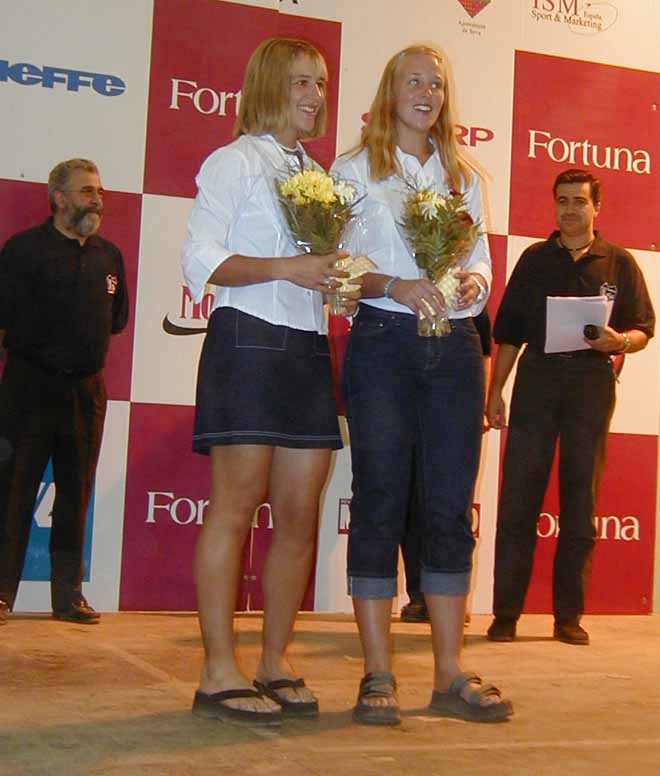

2000 Seva, Spain - with her sister Kerry

2001 La Bresse, France
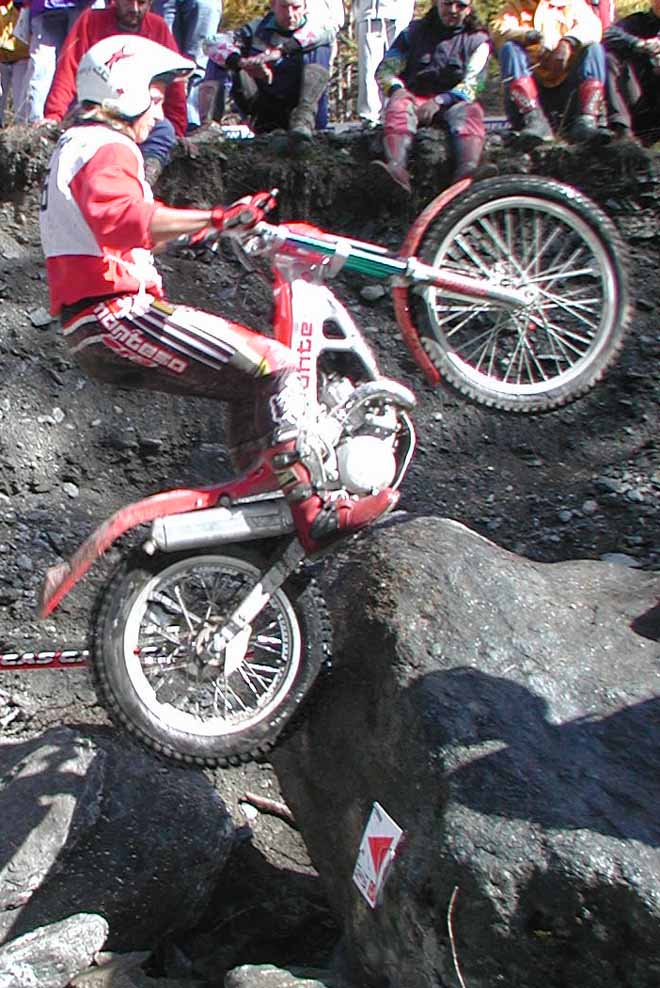
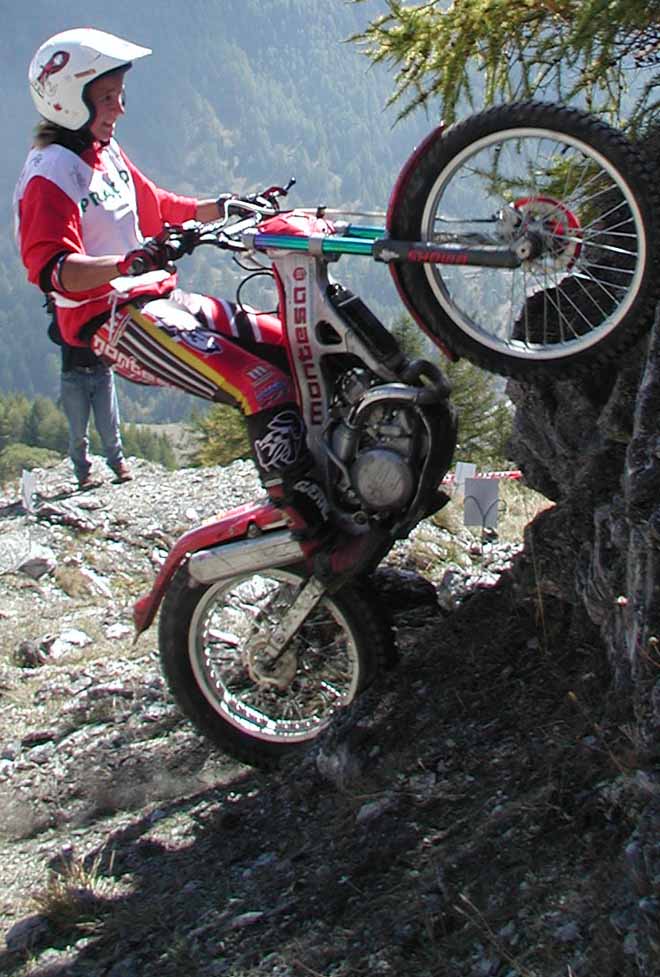
2001 Pragelato TO, Italy

2003 Scottish Six Days Trial
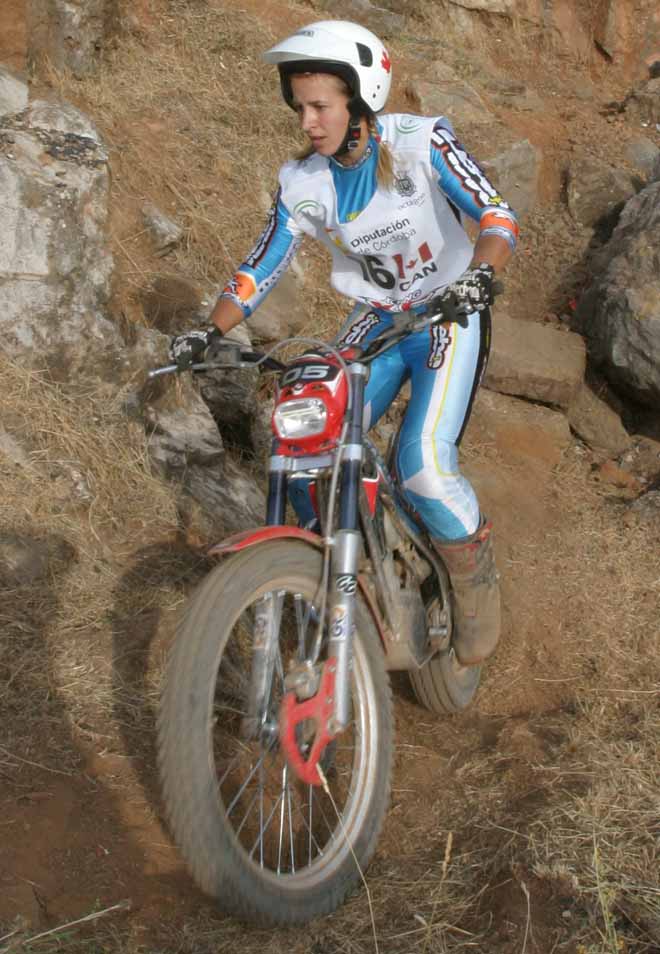
2004 Cordoba, Spain
2006 Breal Sous Montfort, France
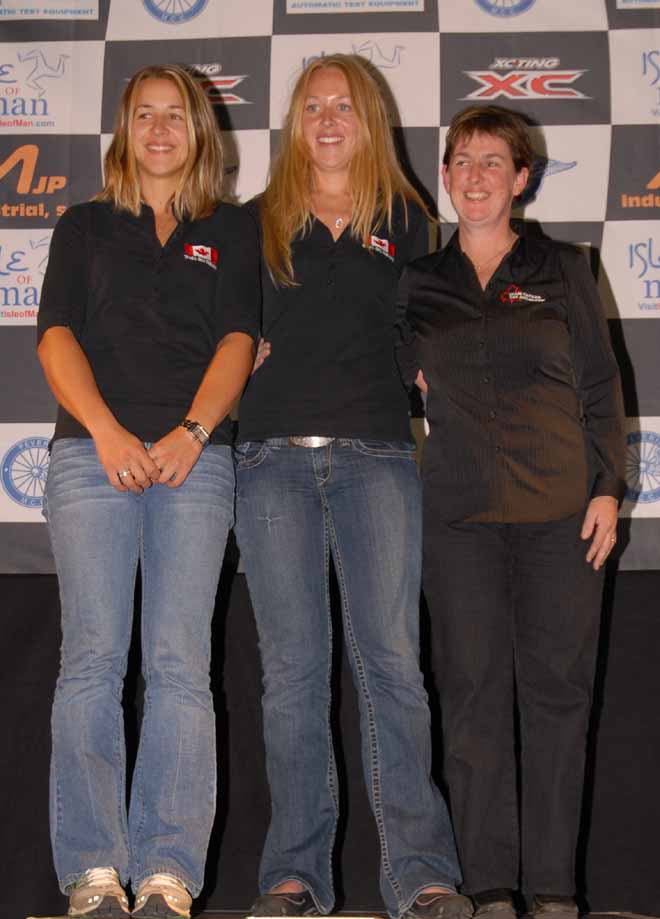
2007 Isle Of Man, UK - beside Kerry, Jean Bancroft
2008 Santa Julia de Loria, Andorra
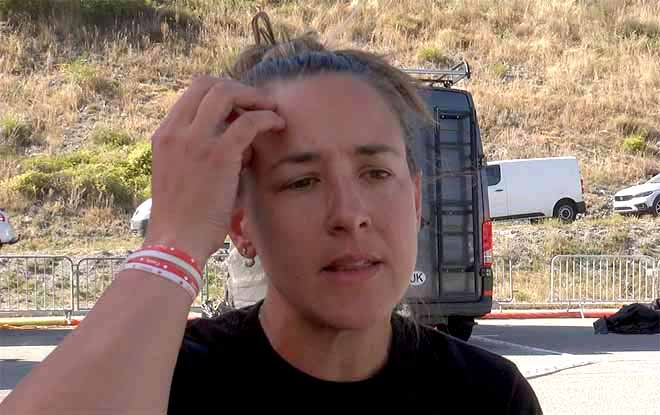
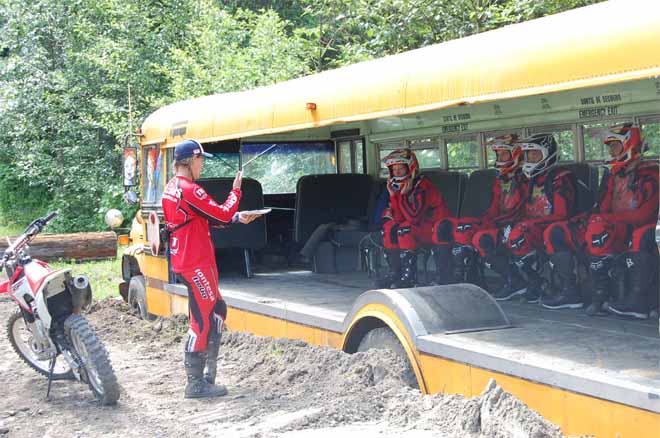
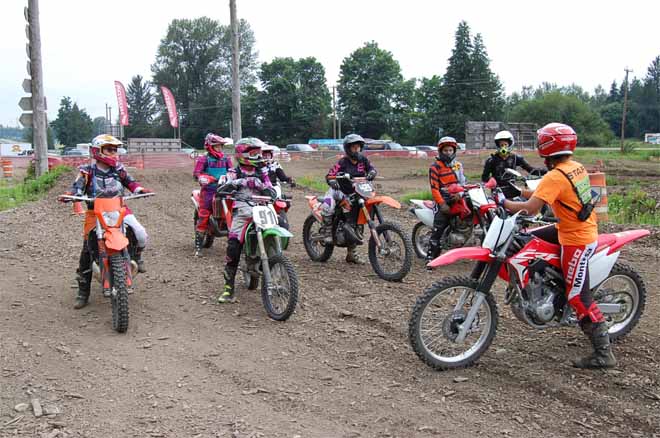

... nowadays, teaching Enduro too .../ ... attualmente insegnando anche Enduro

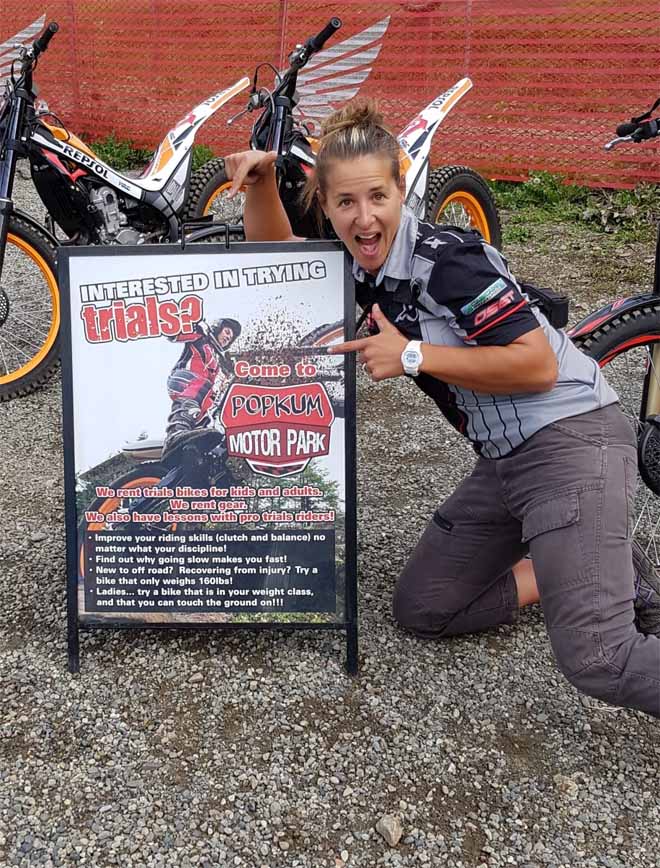
... working hard / in piena attività ...

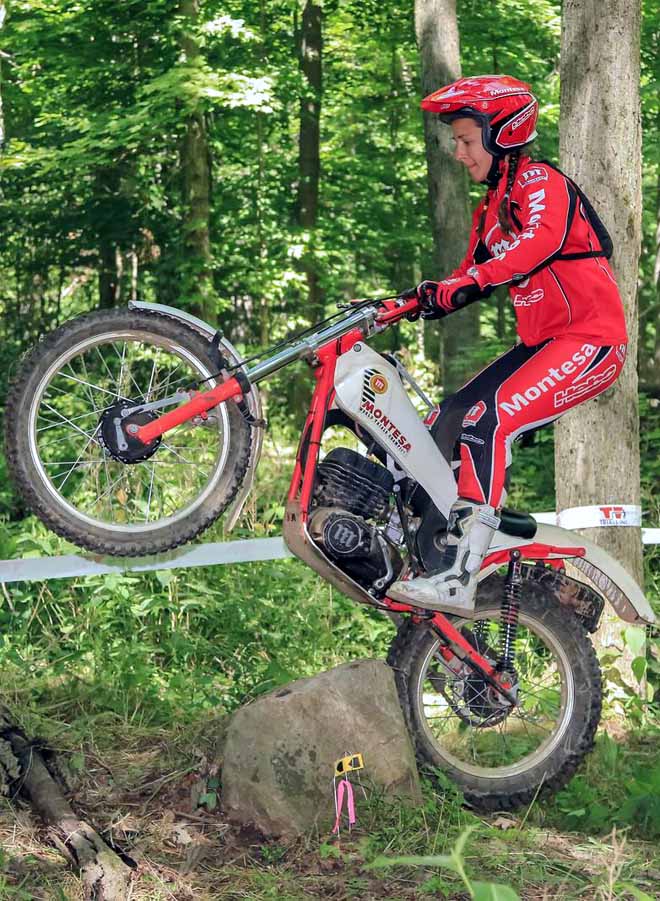
...not too keen on vintage/ non troppo entusiasta del vintage

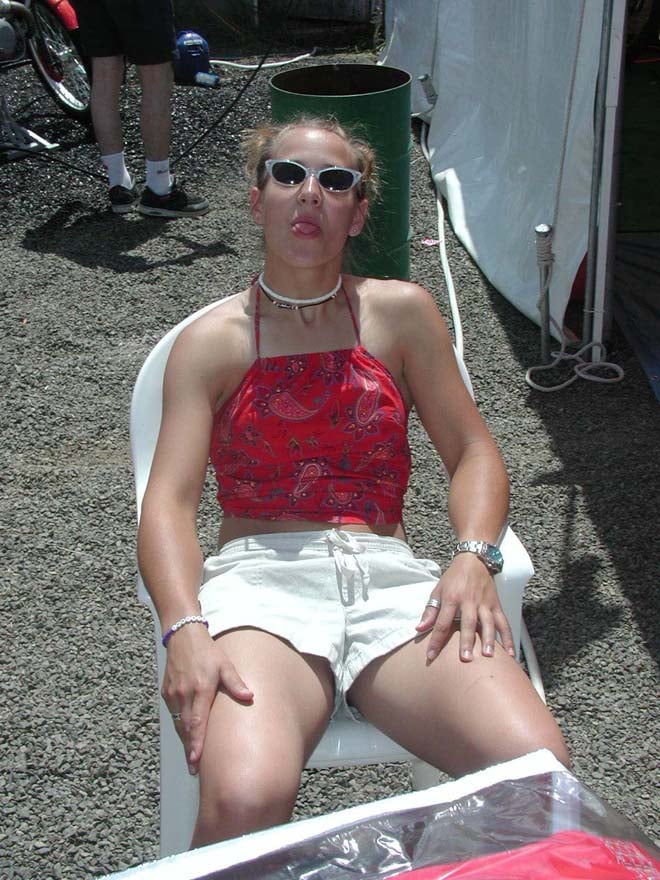
...a sign of his affection / un suo segno d'affetto ...
---------------------------------------------------------------------------------------

